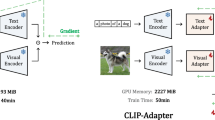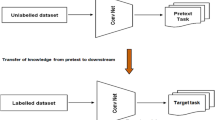Abstract
Few-shot learning aims to discriminate images from novel categories using only a few available training examples. While existing few-shot methods can adapt quickly and precisely to new categories, they often struggle to retain knowledge of base categories that were used in the training phase. To address this challenge and support lifelong learning, generalized few-shot learning has been introduced to enable few-shot models to classify both base and novel categories. However, as the number of categories increases, few-shot models can lose efficiency due to the limited amount of visual information available for each category. To address this limitation, we propose the knowledge-augmented weight generation (KAWG) method, which incorporates semantic information in addition to visual features. Specifically, KAWG combines textual descriptions and entity relationships extracted from knowledge graphs and visual features to generate more robust classifiers for generalized few-shot learning tasks. Through our meta-training strategy, KAWG can retain the knowledge learned from base categories to the greatest extent when transferring to novel classes. Experiments show that our approach achieves state-of-the-art performance on some generalized few-shot benchmarks.






Similar content being viewed by others
References
Snell J, Swersky K, Zemel R (2017) Prototypical networks for few-shot learning. Advances in neural information processing systems 30
Vinyals O, Blundell C, Lillicrap T, Wierstra D et al (2016) Matching networks for one shot learning. In: Advances in neural information processing systems, vol 29
Gidaris S, Komodakis N (2019) Generating classification weights with GNN denoising autoencoders for few-shot learning. In: Proceedings of the IEEE/CVF conference on computer vision and pattern recognition, pp 21–30
Sung F, Yang Y, Zhang L, Xiang T, Torr PH, Hospedales TM (2018) Learning to compare: relation network for few-shot learning. In: Proceedings of the IEEE conference on computer vision and pattern recognition, pp 1199–1208
Ye H-J, Hu H, Zhan D-C, Sha F (2020) Few-shot learning via embedding adaptation with set-to-set functions. In: Proceedings of the IEEE/CVF conference on computer vision and pattern recognition, pp 8808–8817
Weiss K, Khoshgoftaar TM, Wang D (2016) A survey of transfer learning. J Big Data 3(1):1–40
Finn C, Abbeel P, Levine S (2017) Model-agnostic meta-learning for fast adaptation of deep networks. In: International conference on machine learning. PMLR, pp 1126–1135
Wang Y, Yao Q, Kwok JT, Ni LM (2020) Generalizing from a few examples: a survey on few-shot learning. ACM Comput Surv (CSUR) 53(3):1–34
Chen W-Y, Liu Y-C, Kira Z, Wang Y-CF, Huang J-B (2019) A closer look at few-shot classification. arXiv preprint arXiv:1904.04232
Hospedales T, Antoniou A, Micaelli P, Storkey A (2021) Meta-learning in neural networks: a survey. IEEE Trans Pattern Anal Mach Intell 44(9):5149–5169
Li A, Luo T, Xiang T, Huang W, Wang L (2019) Few-shot learning with global class representations. In: Proceedings of the IEEE/CVF international conference on computer vision, pp 9715–9724
Gidaris S, Komodakis N (2018) Dynamic few-shot visual learning without forgetting. In: Proceedings of the IEEE conference on computer vision and pattern recognition, pp 4367–4375
Qi H, Brown M, Lowe DG (2018) Low-shot learning with imprinted weights. In: Proceedings of the IEEE conference on computer vision and pattern recognition, pp 5822–5830
Chen F, Zhang D, Han M, Chen X, Shi J, Xu S, Xu B (2022) VLP: a survey on vision-language pre-training. arXiv preprint arXiv:2202.09061
Zhou L, Palangi H, Zhang L, Hu H, Corso J, Gao J (2020) Unified vision-language pre-training for image captioning and VQA. In: Proceedings of the AAAI conference on artificial intelligence, vol 34, pp 13041–13049
Lin Y, Chi Y, Han H, Han M, Guo Y (2022) Multimodal orthodontic corpus construction based on semantic tag classification method. Neural Process Lett 54(4):2817–2830
Ngiam J, Khosla A, Kim M, Nam J, Lee H, Ng AY (2011) Multimodal deep learning. In: ICML
Miller GA (1995) Wordnet: a lexical database for English. Commun ACM 38(11):39–41
Long M, Wang J, Ding G, Sun J, Yu PS (2013) Transfer feature learning with joint distribution adaptation. In: Proceedings of the IEEE international conference on computer vision, pp 2200–2207
Zhao J, Tang T, Yu Y, Wang J, Yang T, Chen M, Wu J (2022) Adaptive meta transfer learning with efficient self-attention for few-shot bearing fault diagnosis. Neural Process Lett 2020:1–20
He Y, Zang C, Zeng P, Dong Q, Liu D, Liu Y (2022) Convolutional shrinkage neural networks based model-agnostic meta-learning for few-shot learning. Neural Process Lett 2022:1–14
Wang Q, Wang G, Kou G, Zang M, Wang H (2021) Application of meta-learning framework based on multiple-capsule intelligent neural systems in image classification. Neural Process Lett 53(4):2581–2602
Oreshkin B, Rodríguez López P, Lacoste A (2018) Tadam: task dependent adaptive metric for improved few-shot learning. In: Advances in neural information processing systems, vol 31
Ravi S, Larochelle H (2016) Optimization as a model for few-shot learning
Lyu B, Wen S, Shi K, Huang T (2023) Multiobjective reinforcement learning-based neural architecture search for efficient portrait parsing. IEEE Trans Cybern 53(2):1158–1169. https://doi.org/10.1109/TCYB.2021.3104866
Lyu B, Hamdi M, Yang Y, Cao Y, Yan Z, Li K, Wen S, Huang T (2023) Efficient spectral graph convolutional network deployment on memristive crossbars. IEEE Trans Emerg Top Comput Intell 7(2):415–425. https://doi.org/10.1109/TETCI.2022.3210998
Zhu Z, Lin X (2021) Kan: knowledge-augmented networks for few-shot learning. In: ICASSP 2021-2021 IEEE International Conference on Acoustics, Speech and Signal Processing (ICASSP). IEEE, pp 1735–1739
Chen R, Chen T, Hui X, Wu H, Li G, Lin L (2020) Knowledge graph transfer network for few-shot recognition. In: Proceedings of the AAAI conference on artificial intelligence, vol 34, pp 10575–10582
Kampffmeyer M, Chen Y, Liang X, Wang H, Zhang Y, Xing EP (2019) Rethinking knowledge graph propagation for zero-shot learning. In: Proceedings of the IEEE/CVF conference on computer vision and pattern recognition pp 11487–11496
Yang S, Liu Y, Zhang Y, Zhu J (2022) A word-concept heterogeneous graph convolutional network for short text classification. Neural Process Lett 2022:1–16
Tian Y, Wang Y, Krishnan D, Tenenbaum JB, Isola P (2020) Rethinking few-shot image classification: a good embedding is all you need? In: European conference on computer vision. Springer, pp 266–282
Rajasegaran J, Khan S, Hayat M, Khan FS, Shah M (2020) Self-supervised knowledge distillation for few-shot learning. arXiv preprint arXiv:2006.09785
Rizve MN, Khan S, Khan FS, Shah M (2021) Exploring complementary strengths of invariant and equivariant representations for few-shot learning. In: Proceedings of the IEEE/CVF conference on computer vision and pattern recognition, pp 10836–10846
Hinton G, Vinyals O, Dean J et al (2015) Distilling the knowledge in a neural network, vol. 2, no. 7. arXiv preprint arXiv:1503.02531
Paulheim H (2017) Knowledge graph refinement: a survey of approaches and evaluation methods. Semant Web 8(3):489–508
Kipf TN, Welling M (2016) Semi-supervised classification with graph convolutional networks. arXiv preprint arXiv:1609.02907
Pennington J, Socher R, Manning CD (2014) Glove: global vectors for word representation. In: Proceedings of the 2014 Conference on Empirical Methods in Natural Language Processing (EMNLP), pp 1532–1543
Ren M, Liao R, Fetaya E, Zemel R (2019) Incremental few-shot learning with attention attractor networks. In: Advances in neural information processing systems, vol 32
Kukleva A, Kuehne H, Schiele B (2021) Generalized and incremental few-shot learning by explicit learning and calibration without forgetting. In: Proceedings of the IEEE/CVF international conference on computer vision, pp 9020–9029
Zhao J, Yang Y, Lin X, Yang J, He L (2021) Looking wider for better adaptive representation in few-shot learning. In: Proceedings of the AAAI conference on artificial intelligence, vol 35, pp 10981–10989
Liu C, Fu Y, Xu C, Yang S, Li J, Wang C, Zhang L (2021) Learning a few-shot embedding model with contrastive learning. In: Proceedings of the AAAI conference on artificial intelligence, vol 35, pp 8635–8643
Zhang C, Ding H, Lin G, Li R, Wang C, Shen C (2021) Meta navigator: search for a good adaptation policy for few-shot learning. In: Proceedings of the IEEE/CVF international conference on computer vision, pp 9435–9444
Gao Z, Wu Y, Jia Y, Harandi M (2021) Curvature generation in curved spaces for few-shot learning. In: Proceedings of the IEEE/CVF international conference on computer vision, pp 8691–8700
Zhou Z, Qiu X, Xie J, Wu J, Zhang C (2021) Binocular mutual learning for improving few-shot classification. In: Proceedings of the IEEE/CVF international conference on computer vision, pp 8402–8411
Xu W, Wang H, Tu Z (2020) Attentional constellation nets for few-shot learning. In: International conference on learning representations
Author information
Authors and Affiliations
Contributions
DL is the first author, LB is the second author and the corresponding author, TY is the third author
Corresponding author
Ethics declarations
Conflict of interest
The authors declare no competing interests.
Additional information
Publisher's Note
Springer Nature remains neutral with regard to jurisdictional claims in published maps and institutional affiliations.
Rights and permissions
Springer Nature or its licensor (e.g. a society or other partner) holds exclusive rights to this article under a publishing agreement with the author(s) or other rightsholder(s); author self-archiving of the accepted manuscript version of this article is solely governed by the terms of such publishing agreement and applicable law.
About this article
Cite this article
Liu, D., Bai, L. & Yu, T. Generalized Few-Shot Classification with Knowledge Graph. Neural Process Lett 55, 7649–7666 (2023). https://doi.org/10.1007/s11063-023-11278-1
Accepted:
Published:
Issue Date:
DOI: https://doi.org/10.1007/s11063-023-11278-1




